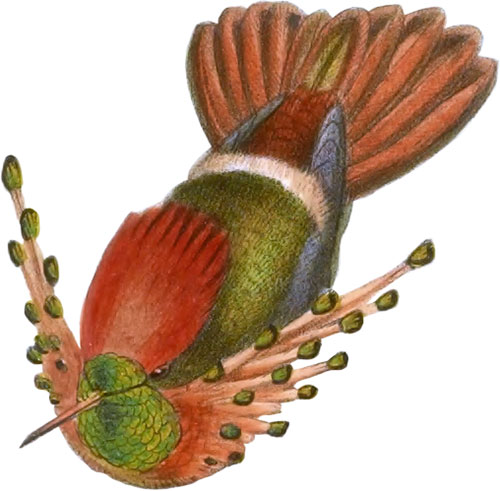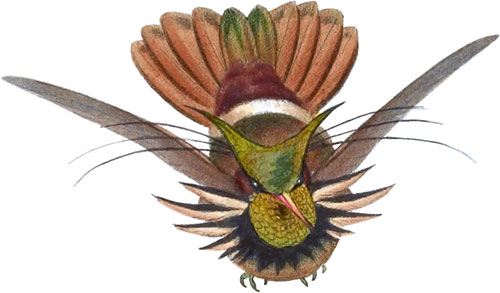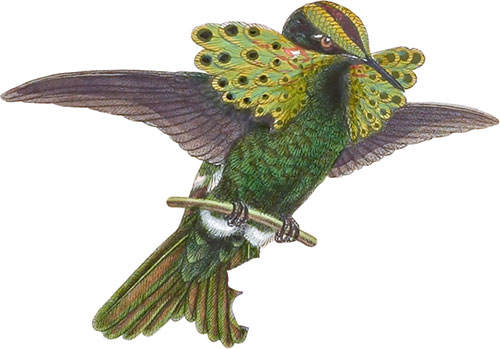Mr. Savin must have been pleased when the male of this Humming-bird came under his notice, and when he saw how different it was from all its immediate allies.
The extreme beauty of the little fairy demanded some pretty euphonious name; and he applied to it that of adorabilis, one which, I doubt not, will last to the end of time. The well-read Trochilidist will not require to be told that there are now ten species of this ornamental group, nine of which have been figured in vol. iii. of the ‘Monograph,’ published twenty years ago.
The tenth, which I now figure, will, I trust, with many others equally rare, add materially to the usefulness and interest of this ‘Supplement.’
In my former work I placed all the species enumerated below in the single genus Lophornis; but since that date they have been separated into no less than five genera, none of which was proposed by myself, though I think that they are very fairly recognizable:—
The following is Mr. Osbert Salvin’s account of this novelty:—
This beautiful species is singularly distinct from any of its congeners, but perhaps belongs rather to the L. magnifica group than to that containing L. helenæ. In the whole genus, however, no other member has the erectile feathers on the forehead, the thread-like white plumes of the crest, or the long pointed feathers of the throat, all of which render this bird most distinct when compared with its allies.
The first specimen obtained by Arcé was a female, which, though evidently belonging to a distinct species, I hesitated to describe. The specimen was shot at Bugaba. ‘The last collection includes the male, which Arcé tells me his brother David obtained high up on the volcano of Chiriqui. That so fine a bird should have remained so long undiscovered seems singular; but the fact, I think, shows that the range of the species is extremely limited.
No less than two other species of Lophornis are found in this portion of Central America, viz.:—L. helenæ, the Mexican and Guatemalan bird, which is also to be met with in Costa Rica; and the southern L. delattrii, which seems to be abundant about Calobre and on the Isthmus of Panama.
Mr. Elliot states that the male has the forehead ruby-red; crown pure white, narrowing to a point on the occiput, from each side of which springs a few narrow, lengthened, dark green feathers; sides of the head, bordering the white, dark brown; back and wing-coverts bronzy green; rump dark purple, crossed by a narrow white band; throat metallic dark green; upper part of the breast white; flanks bronzy green; abdomen and under tail-coverts dark rufous; tail deep rufous, with the tips of the median feathers and edges of the others greenish brown; wings purple.
Female. Head and ears black; throat white, sparingly spotted with golden green; tail banded with a broad bar near the extremity; median rectrices tinged in the middle with a greenish tint.
Total length 2\(\frac{7}{8}\) inches, wing 1\(\frac{5}{8}\), tail 1\(\frac{3}{16}\), culmen \(\frac{3}{8}\).
 Lophornis ornatus
Tufted Coquette
Lophornis ornatus
Tufted Coquette
 Lophornis Gouldi
Gould’s Coquette
Lophornis Gouldi
Gould’s Coquette
 Lophornis magnificus
Frilled Coquette
Lophornis magnificus
Frilled Coquette
 Lophornis Regulus
Great-Crested Coquette
Lophornis Regulus
Great-Crested Coquette
 Lophornis Delattrei
DeLattre’s Coquette
Lophornis Delattrei
DeLattre’s Coquette
 Lophornis Reginæ
Spangled Coquette
Lophornis Reginæ
Spangled Coquette
 Lophornis Helenæ
Princess Helena’s Coquette
Lophornis Helenæ
Princess Helena’s Coquette
 Lophornis pavoninus
Roraima Coquette
Lophornis pavoninus
Roraima Coquette
Featuring all 422 illustrated species from John Gould’s A Monograph of the Trochilidæ, or Family of Humming-Birds arranged by color.